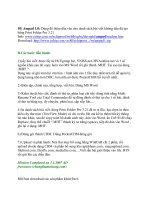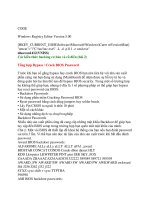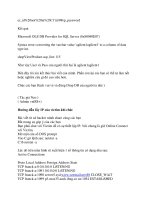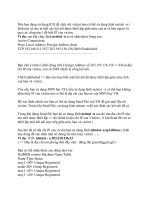HandBooks Professional Java-C-Scrip-SQL part 225 ppsx
Bạn đang xem bản rút gọn của tài liệu. Xem và tải ngay bản đầy đủ của tài liệu tại đây (45.11 KB, 15 trang )
Ruby in a Nutshell
By Yukihiro Matsumoto
Chapter 2.
Language Basics
2.2 Environment Variables
In addition to using arguments and options on the command line, the Ruby
interpreter uses the following environment variables to control its behavior. The
ENV object contains a list of current environment variables.
DLN_LIBRARY_PATH
Search path for dynamically loaded modules.
HOME
Directory moved to when no argument is passed to Dir::chdir. Also
used by File::expand_path to expand "~".
LOGDIR
Directory moved to when no arguments are passed to Dir::chdir and
environment variable HOME isn't set.
PATH
Search path for executing subprocesses and searching for Ruby programs
with the -S option. Separate each path with a colon (semicolon in DOS and
Windows).
RUBYLIB
Search path for libraries. Separate each path with a colon (semicolon in DOS
and Windows).
RUBYLIB_PREFIX
Used to modify the RUBYLIB search path by replacing prefix of library
path1 with path2 using the format path1;path2 or path1path2
. For
example, if RUBYLIB is:
/usr/local/lib/ruby/site_ruby
and RUBYLIB_PREFIX is:
/usr/local/lib/ruby;f:/ruby
Ruby searches f:/ruby/site_ruby. Works only with DOS, Windows,
and OS/2 versions.
RUBYOPT
Command-line options passed to Ruby interpreter. Ignored in taint mode
(where $SAFE is greater than 0).
RUBYPATH
With -S option, search path for Ruby programs. Takes precedence over
PATH. Ignored in taint mode (where $SAFE is greater than 0).
RUBYSHELL
Specifies shell for spawned processes. If not set, SHELL or COMSPEC are
checked.
Top
Ruby in a Nutshell
By Yukihiro Matsumoto
Chapter
2.
Language Basics
2.3 Lexical Conventions
Ruby programs are composed of elements already familiar to most programmers:
lines, whitespace, comments, identifiers, reserved words, literals, etc. Particularly
for those programmers coming from other scripting languages such as Perl, Python
or tcl, you'll find Ruby's conventions familiar, or at least straightforward enough
not to cause much trouble.
2.3.1 Whitespace
We'll leave the thorny questions like "How much whitespace makes code more
readable and how much is distracting?" for another day. If you haven't already
caught onto this theme, the Ruby interpreter will do pretty much what you expect
with respect to whitespace in your code.
Whitespace characters such as spaces and tabs are generally ignored in Ruby code,
except when they appear in strings. Sometimes, however, they are used to interpret
ambiguous statements. Interpretations of this sort produce warnings when the -w
option is enabled.
a
+
b
Interpreted as a+b (a is a local variable)
a +b
Interpreted as a(+b) (a, in this case, is a method call)
2.3.2 Line Endings
Ruby interprets semicolons and newline characters as the ending of a statement.
However, if Ruby encounters operators, such as +, -, or backslash at the end of a
line, they indicate the continuation of a statement.
2.3.3 Comments
Comments are lines of annotation within Ruby code that are ignored at runtime.
Comments extend from # to the end of the line.
# This is a comment.
Ruby code can contain embedded documents too. Embedded documents extend
from a line beginning with =begin to the next line beginning with =end.
=begin and =end must come at the beginning of a line.
=begin
This is an embedded document.
=end
2.3.4 Identifiers
Identifiers are names of variables, constants, and methods. Ruby distinguishes
between identifiers consisting of uppercase characters and those of lowercase
characters. Identifier names may consist of alphanumeric characters and the
underscore character ( _ ). You can distinguish a variable's type by the initial
character of its identifier.
2.3.5 Reserved Words
The following list shows the reserved words in Ruby:
BEGIN do next then
END else nil true
alias elsif not undef
and end or unless
begin ensure redo until
break false rescue when
case for retry while
class if return yield
def in self _ _FILE_ _
defined? module super _ _LINE_ _
These reserved words may not be used as constant or local variable names. They
can, however, be used as method names if a receiver is specified.
Top
Ruby in a Nutshell
By Yukihiro Matsumoto
Chapter 2.
Language Basics
2.4 Literals
I've often wondered why we programmers are so enamored with literals. I'm
waiting for the day when a language comes along and introduces "figuratives." In
the interim, the rules Ruby uses for literals are simple and intuitive, as you'll see
the following sections.
2.4.1 Numbers
Strings and numbers are the bread and butter of literals. Ruby provides support for
both integers and floating-point numbers, using classes Fixnum, Bignum, and
Float.
2.4.1.1 Integers
Integers are instances of class Fixnum or Bignum:
123 # decimal
1_234 # decimal with underline
0377 # octal
0xff # hexadecimal
0b1011 # binary
?a # character code for 'a'
12345678901234567890 # Bignum: an integer of infinite length
2.4.1.2 Floating-point numbers
Floating-point numbers are instances of class Float:
123.4 # floating point value
1.0e6 # scientific notation
4E20 # dot not required
4e+20 # sign before exponential
2.4.2 Strings
A string is an array of bytes (octets) and an instance of class String:
"abc"
Double-quoted strings allow substitution and backslash notation.
'abc'
Single-quoted strings don't allow substitution and allow backslash notation
only for \\ and \'.
2.4.2.1 String concatenation
Adjacent strings are concatenated at the same time Ruby parses the program.
"foo" "bar" # means "foobar"
2.4.2.2 Expression substitution
#$var and #@var are abbreviated forms of #{$var} and #{@var}. Embeds
value of expression in #{ } into a string.
2.4.2.3 Backslash notation
In double-quoted strings, regular expression literals, and command output,
backslash notation can be represent unprintable characters, as shown in Table 2-1.
Table 2-1. Backslash notations
Sequence Character represented
\n Newline (0x0a)
\r Carriage return (0x0d)
\f Formfeed (0x0c)
\b Backspace (0x08)
\a Bell (0x07)
\e Escape (0x1b)
\s Space (0x20)
\nnn
Octal notation (n being 0-7)
\xnn Hexadecimal notation (n being 0-9, a-f, or A-F)
\cx, \C-x
Control-x
\M-x Meta-x (c | 0x80)
\M-\C-x
Meta-Control-x
\x Character x
`command`
Converts command output to a string. Allows substitution and backslash
notation
2.4.2.4 General delimited strings
The delimiter ! in expressions like this: %q! ! can be an arbitrary character. If
the delimiter is any of the following: ( [ { <, the end delimiter becomes the
corresponding closing delimiter, allowing for nested delimiter pairs.
%!foo!
%Q!foo!
Equivalent to double quoted string "foo"
%q!foo!
Equivalent to single quoted string 'foo'
%x!foo!
Equivalent to `foo` command output
2.4.2.5 here documents
Builds strings from multiple lines. Contents span from next logical line to the line
that starts with the delimiter.
<<FOO
FOO
Using quoted delimiters after <<, you can specify the quoting mechanism used for
String literals. If a minus sign appears between << and the delimiter, you can
indent the delimiter, as shown here:
puts <<FOO # String in double quotes ("")
hello world
FOO
puts <<"FOO" # String in double quotes ("")
hello world
FOO
puts <<'FOO' # String in single quotes ('')
hello world
FOO
puts <<`FOO` # String in backquotes (``)
hello world
FOO
puts <<-FOO # Delimiter can be indented
hello world
FOO
2.4.3 Symbols
A symbol is an object corresponding to an identifier or variable:
:foo # symbol for 'foo'
:$foo # symbol for variable '$foo'
2.4.4 Arrays
An array is a container class that holds a collection of objects indexed by an
integer. Any kind of object may be stored in an array, and any given array can
store a heterogeneous mix of object types. Arrays grow as you add elements.
Arrays can be created using array.new or via literals. An array expression is a
series of values between brackets [ ]:
[]
An empty array (with no elements)
[1, 2, 3]
An array of three elements
[1, [2, 3]]
A nested array
2.4.4.1 General delimited string array
You can construct arrays of strings using the shortcut notation, %W. Only
whitespace characters and closing parentheses can be escaped in the following
notation:
%w(foo bar baz) # ["foo", "bar", "baz"]
2.4.5 Hashes
A hash is a collection of key-value pairs or a collection that is indexed by arbitrary
types of objects.
A hash expression is a series of key=>value pairs between braces.
{key1 => val1, key2 => val2}
2.4.6 Regular Expressions
Regular expressions are a minilanguage used to describe patterns of strings. A
regular expression literal is a pattern between slashes or between arbitrary
delimiters followed by %r:
/pattern/
/pattern/im # option can be specified
%r!/usr/local! # general delimited regular expression
Regular expressions have their own power and mystery; for more on this topic, see
O'Reilly's Mastering Regular Expressions by Jeffrey E.F. Friedl.
2.4.6.1 Regular-expression modifiers
Regular expression literals may include an optional modifier to control various
aspects of matching. The modifier is specified after the second slash character, as
shown previously and may be represented by one of these characters:
i
Case-insensitive
o
Substitutes only once
x
Ignores whitespace and allows comments in regular expressions
m
Matches multiple lines, recognizing newlines as normal characters
2.4.6.2 Regular-expression patterns
Except for control characters, (+ ? . * ^ $ ( ) [ ] { } | \), all characters match
themselves. You can escape a control character by preceding it with a backslash.
Regular characters that express repetition (* + { }) can match very long strings,
but when you follow such characters with control characters ?, you invoke a
nongreedy match that finishes at the first successful match (i.e., +, *, etc.)
followed by ? (i.e., +?, *?, etc.).
^
Matches beginning of line.
$
Matches end of line.
.
Matches any single character except newline. Using m option allows it to
match newline as well.
[ ]
Matches any single character in brackets.
[^ ]
Matches any single character not in brackets.
re*
Matches 0 or more occurrences of preceding expression.
re+
Matches 1 or more occurrences of preceding expression.
re?
Matches 0 or 1 occurrence of preceding expression.
re{ n}
Matches exactly n number of occurrences of preceding expression.
re{ n,}
Matches n or more occurrences of preceding expression.
re{ n, m}
Matches at least n and at most m occurrences of preceding expression.
a| b
Matches either a or b.
( re)
Groups regular expressions and remembers matched text.
(?imx)
Temporarily toggles on i, m, or x options within a regular expression. If in
parentheses, only that area is affected.
(?
-
imx)
Temporarily toggles off i, m, or x options within a regular expression. If in
parentheses, only that area is affected.
(?: re)
Groups regular expressions without remembering matched text.
(?imx: re)
Temporarily toggles on i, m, or x options within parentheses.
(?-imx: re)
Temporarily toggles off i, m, or x options within parentheses.
(?# )
Comment.
(?= re)
Specifies position using a pattern. Doesn't have a range.
(?! re)
Specifies position using pattern negation. Doesn't have a range.
(?> re)
Matches independent pattern without backtracking.
\w
Matches word characters.
\W
Matches nonword characters.
\
s
Matches whitespace. Equivalent to [\t\n\r\f].
\S
Matches nonwhitespace.
\d
Matches digits. Equivalent to [0-9].
\D
Matches nondigits.
\A
Matches beginning of string.
\Z
Matches end of string. If a newline exists, it matches just before newline.
\z
Matches end of string.
\G
Matches point where last match finished.
\b
Matches word boundaries when outside brackets. Matches backspace (0x08)
when inside brackets.
\B
Matches nonword boundaries.
\
n
,
\
t,
etc.
Matches newlines, carriage returns, tabs, etc.
\1 \9
Matches nth grouped subexpression.
\10
Matches nth grouped subexpression if it matched already. Otherwise refers
to the octal representation of a character code.









